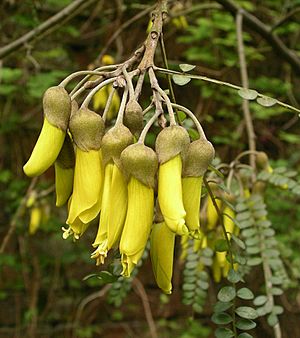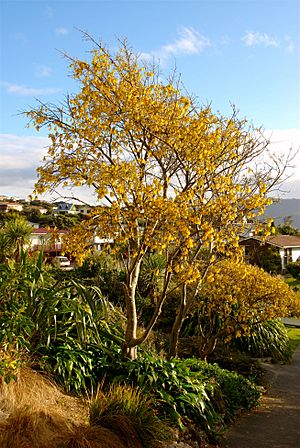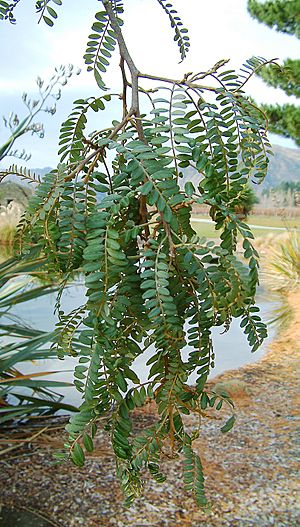Kōwhai facts for kids
Kōwhai are special trees and shrubs that grow naturally in New Zealand. They belong to a group of plants called legumes. There are eight different types of kōwhai. The most well-known are Sophora microphylla and S. tetraptera, which can grow into large trees.
You can often find kōwhai trees growing near streams or at the edges of forests. They are also a common sight in gardens all over New Zealand. Outside of New Zealand, kōwhai usually only grow in places with mild, gentle weather near the sea.
Many people think the bright yellow kōwhai flowers are New Zealand's national flower. Even though they don't have an official title, they are very popular! The word kōwhai also means the colour yellow in the Māori language, because of the flowers' colour. Sometimes, people spell it "kowhai" without the special mark over the 'o'.
Contents
Types of Kōwhai Trees
There are eight main types, or species, of kōwhai:
- Sophora chathamica, also known as coastal kōwhai
- Sophora fulvida, or Waitakere kōwhai
- Sophora godleyi, Godley's kōwhai
- Sophora longicarinata, the limestone kōwhai
- Sophora microphylla, known as small-leaved kōwhai
- Sophora molloyi, the Cook Strait kōwhai
- Sophora prostrata, called prostrate kōwhai
- Sophora tetraptera, the large-leaved kōwhai
What Kōwhai Look Like
Most kōwhai trees grow to about 8 metres (about 26 feet) tall. They have smooth bark and small leaves. The S. microphylla type has tiny leaves, about half a centimetre long. Its flowers are also smaller, around 2.5 to 3.5 centimetres long. The S. tetraptera type has slightly bigger leaves, about 1 to 2 centimetres long, and larger flowers, 3 to 5 centimetres long.
After the flowers bloom, kōwhai trees grow very unique seed pods. These pods look like they are split into sections. Each pod holds six or more smooth, hard seeds. Most kōwhai species have yellow seeds. However, Sophora prostrata has black seeds. If you see many hundreds of bright yellow seeds on the ground, it's a sure sign a kōwhai tree is nearby!
Many kōwhai trees are semi-deciduous. This means they lose most of their leaves right after flowering, usually in October or November. But don't worry, new leaves quickly grow back! Kōwhai trees flower at different times from July to November. This means there's always nectar for birds like tui, wood pigeons, and bellbirds. Tui especially love kōwhai nectar and will fly far to find it.
The wood from kōwhai trees is very strong and heavy. In the past, people used it to make tools and parts for machines.
How Kōwhai Grow
You can grow kōwhai trees from seeds or from small branch cuttings. The best times to plant them are in spring or autumn. The seeds are usually dark or bright yellow. To help them grow, you can gently scratch the hard outer shell of the seed. Then, soak the seeds in water for several hours. Another trick is to put them in boiling water for a few minutes to soften the shell. After that, let them soak in the same water as it cools down.
Young kōwhai plants are sensitive to frost. It's best to plant them outside when they are in their second year and are at least 30 centimetres (about 1 foot) tall. If you grow a kōwhai from a seed, it can take many years for it to start flowering. The exact number of years depends on the type of kōwhai.
S. prostrata, sometimes called "little baby," is a small kōwhai. It only grows up to two metres (about 6.5 feet) tall. It has zig-zagging stems and small, spread-out leaves. Because of its unique shape, it is sometimes used as a bonsai tree.
Important Safety Information
It's important to know that all parts of the kōwhai tree can be harmful if eaten, especially the seeds. However, there have been no confirmed cases of serious poisoning in humans from eating kōwhai in New Zealand. It's always best to be careful and not eat any parts of the plant.
Traditional Māori Uses
The Māori traditionally used kōwhai trees in many ways. They used the flexible branches to build parts of their houses. They also used them to make traps for catching birds. The bright yellow kōwhai flowers were used to make a yellow dye.
The blooming of kōwhai flowers was also a sign for Māori. When the flowers appeared in late winter and early spring, it was time to plant kumara (sweet potato).
Māori also used the kōwhai tree for medicine. They would heat the bark with hot stones in a special container called a calabash. This heated bark was then made into a soft paste, called a poultice. This poultice was used to treat wounds or rubbed on sore backs. They also made a liquid medicine, called an infusion, from the bark to help with bruises or muscle pains. If someone was bitten by a seal, a special kōwhai infusion called wai kōwhai was put on the wounds. It was believed that the person would get better in just a few days.
|





